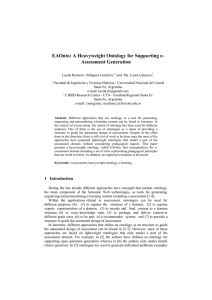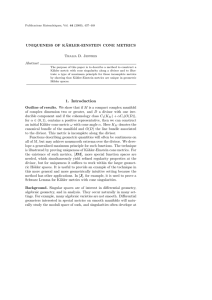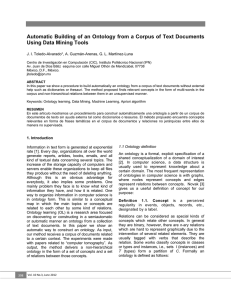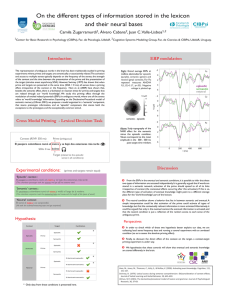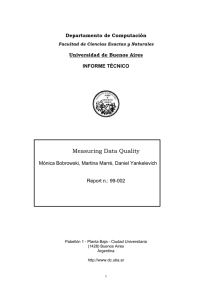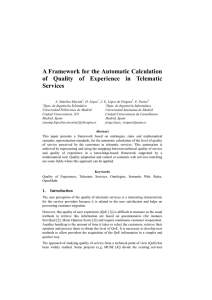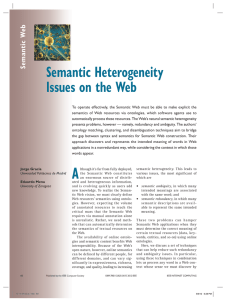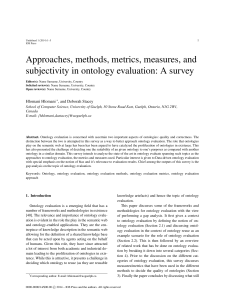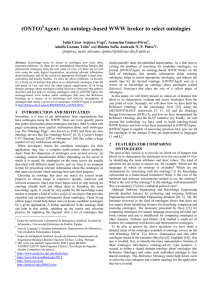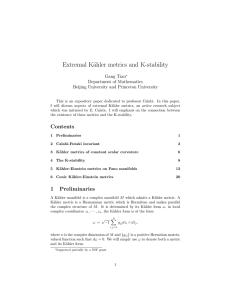An Ontological Approach to Analyze the Data Required by
Anuncio
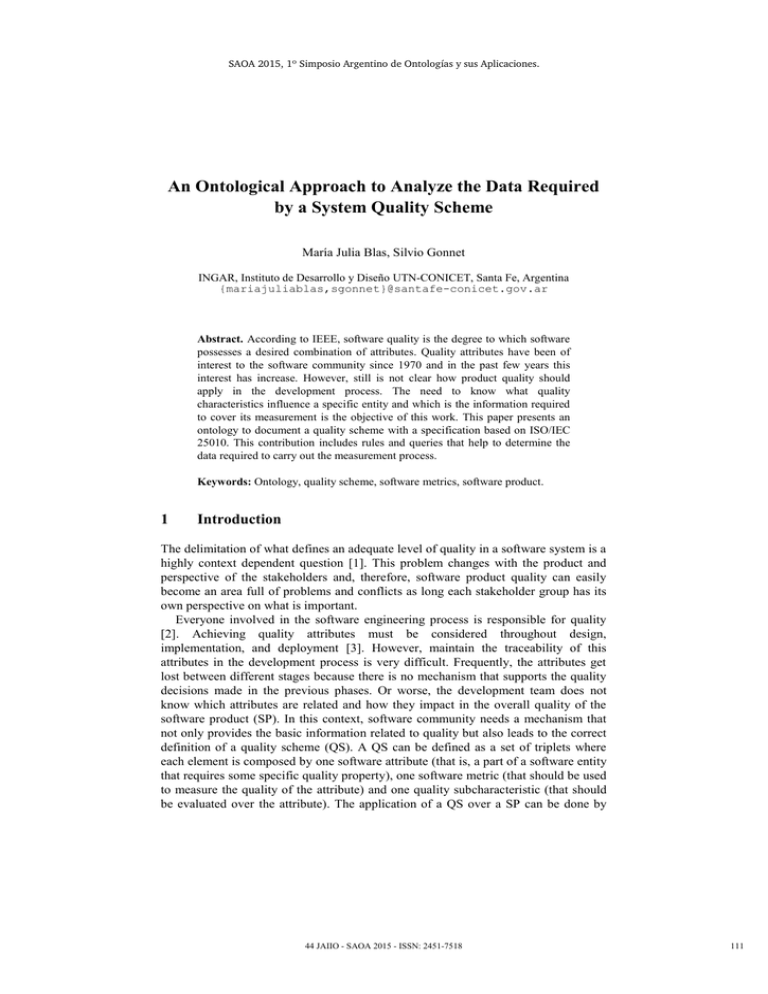
SAOA 2015, 1º Simposio Argentino de Ontologías y sus Aplicaciones.
An Ontological Approach to Analyze the Data Required
by a System Quality Scheme
María Julia Blas, Silvio Gonnet
INGAR, Instituto de Desarrollo y Diseño UTN-CONICET, Santa Fe, Argentina
{mariajuliablas,sgonnet}@santafe-conicet.gov.ar
Abstract. According to IEEE, software quality is the degree to which software
possesses a desired combination of attributes. Quality attributes have been of
interest to the software community since 1970 and in the past few years this
interest has increase. However, still is not clear how product quality should
apply in the development process. The need to know what quality
characteristics influence a specific entity and which is the information required
to cover its measurement is the objective of this work. This paper presents an
ontology to document a quality scheme with a specification based on ISO/IEC
25010. This contribution includes rules and queries that help to determine the
data required to carry out the measurement process.
Keywords: Ontology, quality scheme, software metrics, software product.
1
Introduction
The delimitation of what defines an adequate level of quality in a software system is a
highly context dependent question [1]. This problem changes with the product and
perspective of the stakeholders and, therefore, software product quality can easily
become an area full of problems and conflicts as long each stakeholder group has its
own perspective on what is important.
Everyone involved in the software engineering process is responsible for quality
[2]. Achieving quality attributes must be considered throughout design,
implementation, and deployment [3]. However, maintain the traceability of this
attributes in the development process is very difficult. Frequently, the attributes get
lost between different stages because there is no mechanism that supports the quality
decisions made in the previous phases. Or worse, the development team does not
know which attributes are related and how they impact in the overall quality of the
software product (SP). In this context, software community needs a mechanism that
not only provides the basic information related to quality but also leads to the correct
definition of a quality scheme (QS). A QS can be defined as a set of triplets where
each element is composed by one software attribute (that is, a part of a software entity
that requires some specific quality property), one software metric (that should be used
to measure the quality of the attribute) and one quality subcharacteristic (that should
be evaluated over the attribute). The application of a QS over a SP can be done by
44 JAIIO - SAOA 2015 - ISSN: 2451-7518
111
SAOA 2015, 1º Simposio Argentino de Ontologías y sus Aplicaciones.
executing the measurement process over the specified artifact. However, before this
application is necessary to collect all the required information. Given that this
information may not be available is useful to analyze how a subset of data covers the
required metrics. To this purpose, this paper presents an ontological approach that
allows developers to document a QS and helps to analyze its coverage (taking into
account the availability of the information). This proposal defines three basic
elements: i) a quality scheme ontology (QSO) that establishes a way to define an
adequate QS; ii) a set of SWRL (Semantic Web Rule Language) rules [4] and
SPARQL (SPARQL Protocol and RDF Query Language) queries [5] that allows
developers to know the degree in which the available information covers the scheme;
and iii) an interactive activity which indicates how to use the previous elements. The
QSO proposed is based on three semantic models: software product quality semantic
model, metric semantic model and software semantic model. Although a lot of
authors have proposed ontologies for quality models and software metrics [6-8].
These ontologies are very detailed representation of a specific domain and their
combination is a complex task. Furthermore, the existing quality model ontologies are
outdated because the current normative [9] is relatively new. Therefore, none of these
ontologies is valid in the actual context.
The remainder of this paper is organized as follows. Section 2 describes the QSO
that should be used to define a QS for a specific SP. Section 3 explains the set of rules
and queries developed in order to derivate the coverage degree. Section 4 presents the
activity defined to apply the ontological approach. Finally, Section 5 is devoted to the
conclusions of the work.
2
Quality Scheme Ontology
The QSO developed is a domain ontology, since is applicable to a domain with a
specific view point [10]. This ontology is based on the combination of three semantic
models that represent specifics domains:
1. A software product quality semantic model that represents a product quality model.
2. A metric semantic model that represents concepts related to software metrics.
3. A software semantic model that represents the content of a software product.
A quality model is an essential component of a QS since is a model with the objective
to describe, assess and/or predict quality [11]. Software quality models are a wellaccepted means to support quality management of software systems. Furthermore, the
use of metrics to develop strategies for improving the quality of the end product is a
good practice [2]. A software metric is a measure of some property of a piece of
software code or its specifications [12]. Software quality metrics are useful to register
the current quality state of an end-product or process. To define a correct QS is
necessary to specify which artifacts of the software product have to be evaluated.
The proposed QSO unifies the three individual domains in a single model. An
attribute of a SP needs to be described by a quality subcharacteristic and has to be
measured by a metric. In this sense, the three elements define one specification of the
44 JAIIO - SAOA 2015 - ISSN: 2451-7518
112
SAOA 2015, 1º Simposio Argentino de Ontologías y sus Aplicaciones.
set of triples included at QS. Therefore, for each quality subcharacteristic, the
capability of a SP is determined by a set of internal attributes that can be measured.
Figure 1 shows the QSO. The gray nodes represent the concepts while the arrows
refer to the relationships. The arrow head indicates the direction of the relationship
and its label indicates the name. The empty arrows model “is-a” relationship, disjoint
and complete. The relationships highlighted in yellow represent links between the
different models. The boxes model the data properties of the concepts.
The upper part of Figure 1 shows the Software Product Quality Semantic Model.
Many quality models have been proposed to support stakeholders in dealing with
software quality. By novelty and completeness, the SP quality model presented in
ISO/IEC 25010 [9] is the most rigorous and complete of all. For these reasons, this
model has been taken as basis for this work.
The product quality model identifies the main characteristics of a SP in different
levels of hierarchy. It is composed of eight characteristics which are further
subdivided into subcharacteristics. A characteristic represents an external quality view
while a subcharacteristic refers to properties that can be evaluated when the software
is used as a part of a system. Each subcharacteristic is decomposed into a set of
attributes. An attribute is an entity which can be verified or measured in the SP. A
detail description of these concepts and relationships can be checked in [9].
In order to build this ontology, each characteristic and subcharacteristic identified
in the quality model was transformed in a concept. The relationships between these
concepts were modeled defining links between them. This definition took the form isdecomposed-in. For example, the characteristic Functional Suitability is related with
the subcharacteristic Functional Appropriateness by the relationship called isdecomposed-in-functional-appropriateness. To group these concepts in different
categories, the concepts Characteristic and Subcharacteristic were included. This
classification was made linking the concepts by an is-a relationship. This relationship
allows to modeling the taxonomy proposed in ISO/IEC 25010 [9]. The Quality Model
concept was also included in the semantic model. The relationship of this concept
with each characteristic was made by defining a new relationship that took the name
contains (e.g. contains-security). The includes relationship helps to determine which
characteristic are included in a Quality Model (since none of the characteristic is
mandatory). Once the main concepts were defined, a set of properties was included in
the model with the aim to refine the represented semantic. These properties include:
characteristic description, subcharacteristic description and source.
To complete the definition of the ontology, a set of SWRL rules related with the
contains relationship were specified. Equation 1 describes an example restriction that
shows that all security characteristic decomposed in an integrity subcharacteristic
must contain this subcharacteristic. Similar restrictions were added to the model to
guarantee that all characteristics contain the appropriate set of subcharacteristics.
Security(?x)∧isDecomposedInIntegrity(?x,?y)→contains(?x,?y)
(1)
The bottom part of Figure 1 shows the Metric Semantic Model. The metric
ontology focuses in the traditional metric definition [2, 13, 14] and incorporates some
concepts of the current normative [15, 16]. According to ISO 9126, a metric is
44 JAIIO - SAOA 2015 - ISSN: 2451-7518
113
SAOA 2015, 1º Simposio Argentino de Ontologías y sus Aplicaciones.
basically defined by the specification of its name, purpose, application method,
measurement formula, interpretation, scale type, measure type, input to measurement
and target audience. The identification of the metric is given by its name. For this
reason, the metric name must be related with the information obtained when the
metric is applied. The purpose of the metric is expressed as the question to be
answered by the application of the metric. The metric application method provides an
outline of application while the measurement formula stipulates the mathematical
expression used for the calculation and explains the meanings of the used data
elements. The interpretation of the measured value supplies the range and preferred
values. The scale type defines the dimension of the metric. Scale types used are:
nominal scale, ordinal scale, interval scale, ratio scale and absolute scale. The
measure type involves the specification of the way in which the metric is obtained.
Types used are: size, time and count type. The input to the measurement process
refers to the source of data used in the measurement. Finally, the target audience
identifies the users of the measurement results.
Although all this concepts define a metric, only a set of them was used as part of
the metric ontology. The selection was made taking into account the final objective:
document the metrics related with different quality attributes that should be used to
evaluate a specific SP. In order to do this, the input to measurement and the target
audience are not represented in the model. To define a QS, the specific source of
information for a metric is not important since the measurement process is not
executed. The target audience is also a concept that shows a dependency with the use
of the metric and, therefore, is excluded of the model. The rest of the concepts were
taken to compose the semantic model. Furthermore, in order to improve and complete
the ontology some properties were refined. The first refinement was the incorporation
of the concepts Direct Metric and Indirect Metric. A Direct Metric is an atomic
metrics and an Indirect Metric is defined in term of another metrics. To define a
metric three complementary changes were made: the addition of the hierarchies Unit
and Scale and the incorporation of the Equation concept. The Unit hierarchy was
designed using as reference the proposal of Rijgersberg [17] while the Scale hierarchy
was modeled using the approach described by Olsina [8]. In order to include an
approach that allow to describing how a metric should be calculated, the Equation
concept was added to the model. This concept represents a mathematical formula
composed of mathematical terms, operators and variables.
The derivation of knowledge that refers to specific types of operations, units and
range delimitations is made by mean of SWRL rules. Equation 2 shows as example
that a unit must be assigned into a metric only if its scale is numerical, then the unit
will be the one specified in the scale.
Metric(?m) ∧ NumericalScale(?s) ∧ isDimensionedIn(?m,?s) ∧ isMeasuredIn(?s,?u) ∧
Unit(?u) → hasAsUnit(?m,?u)
(2)
The middle part of Figure 1 shows the Software Semantic Model. Its purpose is to
model the domain of SPs. A SP is a set of computer programs, procedures, and
possibly associated documentation and data, designed for delivery to a specific user.
It always includes the development of one or more computer programs.
44 JAIIO - SAOA 2015 - ISSN: 2451-7518
114
SAOA 2015, 1º Simposio Argentino de Ontologías y sus Aplicaciones.
Fig. 1. Quality Scheme Ontology.
44 JAIIO - SAOA 2015 - ISSN: 2451-7518
115
SAOA 2015, 1º Simposio Argentino de Ontologías y sus Aplicaciones.
The development process carried out for the construction of each computer
program usually involves the creation of different artifacts. An artifact is a product
produced during the development of software that contains information of some part
of it. All artifacts can be divided in a set of entities. An entity is an object that can be
characterized by measuring its attributes. Therefore, an attribute is a measurable
physical or abstract property of an entity.
The semantic model developed is based on this description which is adapted from
[2,15,16,18]. Each of the main concepts identified in the domain was transformed into
an ontology concept. The links between the concepts were modeled as relationships.
The name of these relationships describes the way in which the concepts are related
(e.g. is-divided-in). To allow a correct identification of the instances derived from a
concept, the model includes some attributes labeled as name and type.
The designed ontologies and the proposed SWRL rules were implemented using
Protégé (http://protege.stanford.edu/). Each ontology was implemented in an
individual OWL (Web Ontology Language) file in order to increase the possibility of
reuse it in other contexts. The elements were specified in English and Spanish to
allow multiple language support. The OWL files were imported in a new document
with aim to model the final ontology. This new model incorporates the specification
of the relationships that link the three semantic models.
Given that it is difficult to quantify the quality of ontologies due to the absence of
formal evaluation methods, an analysis of the structural dimensions was applied over
the final ontology. Table 1 describes the set of selected metrics and its results.
Table 1. Metrics applied to the Quality Scheme Ontology.
Abbrev.
Description
Definition
Value
P
Number of non-inheritance relationships.
-
68
H
Number of inheritance relationships.
-
72
NOC
Number of classes.
-
87
NOR
Number of relations.
-
140
NORC
Number of root classes.
-
15
NOLC
Number of leaf classes.
-
72
NAT
Number of attributes for all classes.
-
32
RR
Relationship richness.
P / (H+P)
0.485
0.827
IR
Inheritance richness.
H / NOC
DOSH
Depth of subsumption hierarchy.
-
5
AR
Attribute richness.
NAT/NOC
0.367
The final ontology has an IR of 0.827 which together with the DOSH value (5)
indicate that the proposed ontology is of a vertical nature. This means that represents
knowledge of a specific domain, allowing to instantiate schemes that fit to the quality
specification. Furthermore, the AR value (0.367 attributes per concept) shows that the
attributes allow to restricting the domain. The RR is very close to the average (48.5%)
which implies that the number of hierarchical relationships is a bit greater than the
number of the other kind of associations. In this sense, the ontology maintains an
adequate balance between inheritance relations and associations.
44 JAIIO - SAOA 2015 - ISSN: 2451-7518
116
SAOA 2015, 1º Simposio Argentino de Ontologías y sus Aplicaciones.
3
Analysis of the Required and Available Information
3.1
SWRL Rules Applied to the Derivation of Knowledge
In order to analyze a software QS, a set of SWRL rules was specified (Table 2). The
SWRL is a language that is used to express rules in the form of an implication
between an antecedent (body) and consequent (head) [4] and, therefore, allows to
derivate new knowledge from the instances of a model.
Since all direct metric refers to a measure or is used as component in an indirect
metric, the first rule specifies that a Direct Metric implies a need of information
(Required Data). However, if a required data is available it establishes an Available
Data (rule 2). In this sense, if a Direct Metric is also an Available Data (that is, the
information exists when the measurement process take place) then the metric is a
mathematical term than can be calculated (Calculable Term). This fact is expressed in
rule 3. But, the fact that a mathematical term can be calculated it may involve that
other mathematical terms can be calculated. To this purpose, rules 4 and 5 are
defined. In rule 4, if a Simple Term has as argument a mathematical term that is
calculable then it is a Calculable Term. The same happens with Complex Terms (rule
5). Then, if the mathematical term that resumes the Measurement Function associated
with an Indirect Metric is calculable, the metric is itself a Calculable Term (rule 6).
Finally, rule 7 specifies that if a Metric is a Calculable Term, then it is a Calculable
Metric. This rule allows to determinate if a metric (independently of its type) can be
calculated with the available data.
Table 2. SWRL rules.
Id.
SWRL Rule
1
DirectMetric(?x) → RequiredData(?x)
2
RequiredData(?x) ˄ available(?x, true) → AvailableData(?x)
3
DirectMetric(?x) ˄ AvailableData(?x) → CalculableTerm(?x)
4
SimpleTerm(?s) ˄ CalculableTerm(?a) ˄ hasAsArgument(?s, ?a) → CalculableTerm(?s)
5
ComplexTerm(?c) ˄ CalculableTerm(?a1) ˄ CalculableTerm(?a2) ˄ hasAsFirstArgument(?c, ?a1) ˄
hasAsSecondArgument(?c, ?a2) → CalculableTerm(?c)
6
IndirectMetric(?m) ˄ MeasurementFunction(?f)
isCalculatedBy(?m, ?f) → CalculableTerm(?m)
7
Metric(?m) ˄ CalculableTerm(?m) → CalculableMetric(?m)
3.2
˄
CalculableTerm(?t)
˄
hasDefinition(?f,
?t)
˄
SPARQL Queries
A QS is defined for a specific SP. However, the quality is measured using the
attributes of the entities of the different artifacts of the software product. Therefore,
the coverage analysis of a QS over a set of available information must be done at
artifact level and the results must be detailed at entity level. To this purpose, the
coverage analysis is done at entity level. These results are combined in order to obtain
a value at artifact level.
44 JAIIO - SAOA 2015 - ISSN: 2451-7518
117
SAOA 2015, 1º Simposio Argentino de Ontologías y sus Aplicaciones.
100% coverage in a quality entity exists if all the metrics related to the entity are
calculable. That is, if is available all the information required to calculate the metrics
related with the attributes of an entity E in reference to a quality
characteristic/subcharacteristic Q. However, a full coverage requires of the
availability of all the information and, usually, the data recompilation is not a
complete activity. Some data may be difficult to obtain or may not exist in early
stages of the development process, but still the available data can lead to an
acceptable coverage level of the quality scheme proposed. In these cases, the
coverage will be less than 100%. Equation 3 shows how calculate the coverage level
of an entity E for a quality characteristic/subcharacteristic Q.
(# Calculable metrics of E for Q / # Metrics of E for Q) x 100
(3)
In order to obtain the coverage level for two variables E (entity) and Q
(subcharacteristic), a SPARQL query was specified and implemented in Protégé
(Figure 2). SPARQL is a semantic query language for databases, able to retrieve and
manipulate data stored in Resource Description Framework format. A SPARQL query
contains three main clauses: SELECT, WHERE and FILTER. In the proposed query,
the SELECT clause specifies Equation 3 by calculating the relation between the
quantity of calculable metrics and the overall metrics. The individuals to be counted
in both cases are obtained from the WHERE clause in combination with the FILTER
clause. While the WHERE clause searches all the metrics and calculable metrics
related to an entity E and a quality property Q, the FILTER clause specifies the values
for E and Q. A similar query was designed to link an entity E with a characteristic Q.
The developed query helps to analyze at entity level and, therefore, can be used as
base for the analysis at artifact level. To summarize the artifact level analysis another
SPARQL query was specified. This query helps to estimate the coverage of a quality
property Q (characteristic or subcharacteristic) over an artifact A. For space reasons
the query is not presented in this work.
Fig. 2. SPARQL query.
4
Activity: Analysis of the Quality Scheme Coverage
An activity was defined to combine an instantiation of the QSO (that is, a QS) with
the coverage queries. After a QS has been created (at any moment of the development
process) the coverage can be analyzed. The decision of when execute the coverage
analysis depends on the need of analyze the quality of a SP according to the QS
specification. The coverage analysis provides a mechanism that helps to know how
the available data are useful to estimate several measures.
44 JAIIO - SAOA 2015 - ISSN: 2451-7518
118
SAOA 2015, 1º Simposio Argentino de Ontologías y sus Aplicaciones.
Given that the coverage analysis is made using the available information, this
process can be executed several times using different sets of available data. For
example, the data can be obtained (at different times) from an execution process used
over the existing components or from outcomes of a simulation run. Whatever be the
source of data, the availability of the information is the one that allows estimate the
quantity of metrics of the QS that can be derived. To obtain these results, the member
of the development team that wants to analyze the coverage (User) must follow the
activity described in Figure 3. When the process starts, User wants to know which the
required data is and, in response, the set of SWRL rules (explained in the section 3.1)
should be executed over the Ontology. After that, User must indicate which of the
required data (obtained as result of the previous activity) is available. Then, User
must indicate that wants to find the calculable metrics based on the existing
information. In response, the SWRL rules should be executed (again) over the
Ontology. Once the calculable metrics are obtained, User must define which artifact
(A) and which quality characteristic (Q) wants to analyze, and then, must indicate that
wants to find the coverage level for both elements. Finally, the SPARQL query should
be executed over the Ontology (with A and Q as arguments). The three final activities
can be repeated for multiple pairs (A,Q) once the calculable metrics are obtained.
By following this activity, any user can use the proposed ontology and its
complements to analyze how impact the available data in the quality of a SP.
Fig. 3. Activity to follow to analyze the coverage of a quality scheme.
5
Conclusions and Future Work
The quality of a software system is directly related to the ability of the system to
satisfy its functional, nonfunctional, implied, and specified requirements. In this
paper, an ontology to document quality schemes is proposed. The ontology is
complemented with a set of SWRL rules and SPARQL queries that allow developers
to analyze how a set of available data can be used to calculate the required metrics.
Also, an activity is defined to show how to use the ontology and the other elements.
The implementation of a tool that automates the elaboration of the quality schemes
and the analysis of its coverage is the next step in this direction. The ontology and the
set of rules and queries designed can be taken as base of this tool, using an ontologybased approach. The main purpose of this tool should be the creation, storage,
modification and query of the quality schemes along with the possibility of analyze
44 JAIIO - SAOA 2015 - ISSN: 2451-7518
119
SAOA 2015, 1º Simposio Argentino de Ontologías y sus Aplicaciones.
the coverage for all quality characteristics. With this technological support, the
development team could easily understand the quality aspects related with a specific
software artifact and see how impact the available data in the measurement of quality.
The QSO can be adapted to other types of quality models since the software
product quality semantic model is an independent ontology. Although in this work the
view is centered in the internal quality attributes of a SP, the semantic model can be
replaced with a model that refers to quality in use. Also, it can be replaced with
quality models developed by other authors. The same changes are applicable to the
software ontology. Given that the semantic model is independent, the proposed
approach allows refining the model to represent a more detailed description of a SP.
The improvement of this model is the main objective of the future work to be made.
References
1. Kitchenham, B., Pfleeger, S.: Software Quality: The Elusive Target. IEEE Softw. 13(1996).
2. Pressman, R.: Software Engineering: A Practitioner´s Approach. McGraw-Hill (2010).
3. Bass, L., Clements, P., Kazman, R.: Software Architecture in Practice. Addison-Wesley
Professional (2003).
4. SWRL: A Semantic Web Rule Language, http://www.w3.org/Submission/SWRL/ (2004).
5. SPARQL 1.1 Query Language, http://www.w3.org/TR/sparql11-query/ (2013).
6. Pardo, C., Pino, F., García, F., Piattini, M., Baldassarre, M.: An ontology for the
harmonization of multiple standards and models, Computer Standards & Interfaces, 34, 1,
pp. 48–59 (2012).
7. Dominguez-Mayo, F., Escalona, M., Mejías, M. Ross, M., Stapes, G.: A quality
management based on the Quality Model life cycle, Computer Standards & Interfaces, 34,
4, pp. 396–412 (2012).
8. Olsina, L., Martín, M.: Ontology for Software Metrics and Indicators. J Web Eng. 2, 262–
281 (2003).
9. ISO/IEC 25010:2011 - System and software quality models, (2011).
10. Roussey, C., Pinet, F., Kang, M., Corcho, O.: An Introduction to Ontologies and Ontology
Engineering, Ontologies in Urban Development Projects, Advanced Information and
Knowledge Processing, 1, pp. 9-38 (2011).
11. Deissenboeck, F., Juergens, E., Lochmann, K.: Software quality models: Purposes, usage
scenarios and requirements, ICSE Workshop on Software Quality ’09. pp. 9–14 (2009).
12. El-Haik, B.S., Shaout, A.: Software Design for Six Sigma: A Roadmap for Excellence. John
Wiley & Sons (2010).
13. Fenton, N., Bieman, J.: Software Metrics: A Rigorous and Practical Approach, Third
Edition. CRC Press, Boca Raton (2014).
14. Kan, S.H.: Metrics and Models in Software Quality Engineering. Addison-Wesley
Professional (2003).
15. ISO/IEC TR 9126-2:2003 - Software Product quality - Part 2: External metrics, (2003).
16. ISO/IEC TR 9126-3:2003 - Software Product quality - Part 3: Internal metrics, (2003).
17. Rijgersberg, H., Wigham, M., Top, J.L.: How semantics can improve engineering
processes: A case of units of measure and quantities. Adv. Eng. Inform. 25, 276–287
(2011).
18. ISO/IEC 12207:2008 - Systems & software engineering - Software life cycle processes
(2008).
44 JAIIO - SAOA 2015 - ISSN: 2451-7518
120


